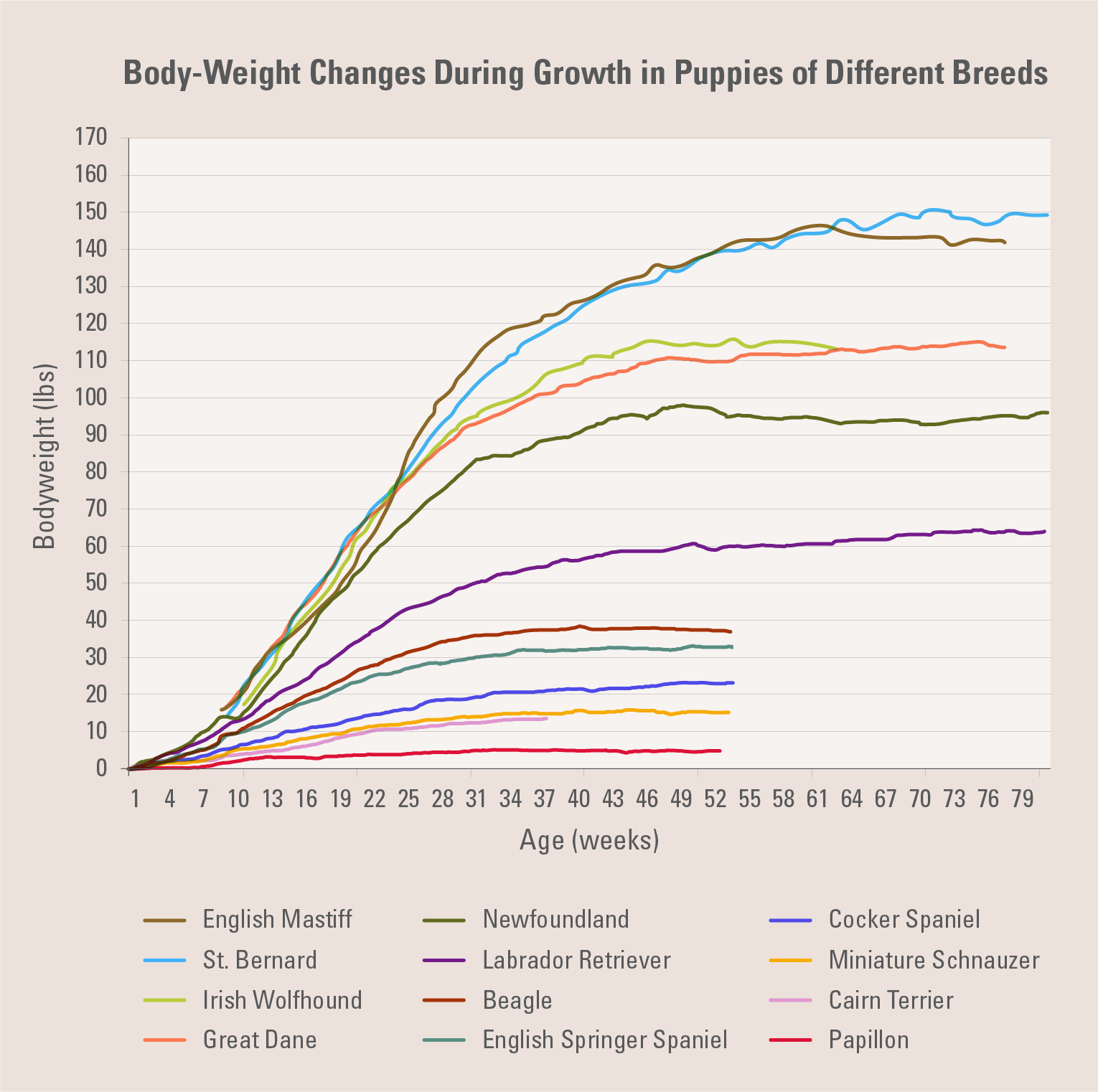Puppies grow rapidly, and they need complete and balanced nutrition to properly fuel that growth and development. Not only do puppies’ nutritional needs differ from adult dogs’, but their requirements vary depending on their breed and size. That’s not surprising when you consider the tremendous variation in dog sizes — from the 4-pound toy poodle to the 180-pound St. Bernard.
Read on to learn more about puppy growth rates and how they influence — and are influenced by — nutrition.
Size matters when talking puppy nutrition
Differences in breed and physical size mean puppies grow and mature at different rates. Dog size is most frequently defined by weight, although the categories and their associated weight ranges vary by source. The most common breed-size categories are small, medium and large, with miniature (toy and teacup) and giant being common subcategories of small and large, respectively. Typically, small breed dogs are those who weigh 20 pounds or less as adults. Medium size dogs are those with an adult weight in the 25- to 55-pound range. Large breed dogs are often defined as those weighing more than 50 pounds as adults, although some groups use 60 pounds as a starting point and the Association of American Feed Control Officials (AAFCO) uses 70 pounds or more.
When it comes to formulating dog food, AAFCO uses life stages rather than weight to distinguish between nutrient profiles — although there’s one exception. The two AAFCO nutrient profile categories are:
- Growth and reproduction (gestation and lactation)
- Adult maintenance
However — here’s where the exception comes into play — if a growth or all-life-stages dog food has been formulated to meet the nutritional requirements specified in the AAFCO dog food nutrient profiles, the adequacy statement must specifically state if the food meets the growth of large size dogs, defined as those who weigh 70 pounds or more as an adult.
Growth rates and patterns are similar, yet different
All puppies, regardless of size, experience their most rapid growth during the first three to six months of life. This rapid growth period is shorter in small breed dogs and ends earlier, when puppies are about 3 months old. In contrast, the exponential growth rate continues for another month in large breed puppies and for another two months in giant breeds.

Adapted from Hawthorne AJ, Booles D, Nugent PA, Gettinby G, Wilkinson J. Body-weight changes during growth in puppies of different breeds. J Nutr. 2004;134(8 Suppl):2027S-2030S.
All puppies are officially considered adult dogs once they reach their first birthday. But because breed sizes vary tremendously, all puppies don’t reach their adult size at the 12-month mark. Toy, small and some medium size dogs get there sooner, around 8 to 10 months of age. Large and giant dogs, along with some medium size dogs, take longer to grow. While some medium size dogs reach their adult size between 9 and 12 months old, large and giant breed dogs don’t reach their mature size until they’re about 11 to 15 months old. And for some giant breed dogs, they may not reach their full mature size until they’re 18 to 24 months old.
Every puppy is an individual and may grow slower or faster than the breed average. Although a dog’s size may stabilize at these ages, your dog’s development will continue for several more months. Once the bones are fully developed, puppies continue to add fat and muscle, just as human adults do.
And all this growth and development takes energy and nutrients.
How differences in growth rate impact nutrient requirements
Proper nutrition is essential to support puppy growth after weaning, and is all about laying the foundation for proper development. Not only is this growth period one of the most nutritionally demanding times for dogs, second only to lactation, but puppies’ nutritional needs change quickly.
As mentioned earlier, the dietary requirements of puppies are different from those of adult dogs. Puppies have greater needs for energy (calories), amino acids and many minerals, including those important for strong bones (calcium and phosphorus) and healthy immune systems (copper and zinc). Studies also show puppies benefit from increased levels of DHA (docosahexaenoic acid), an omega-3 fatty acid found in some fish and fish oils that’s important to brain and vision development.
The most important factor that affects growth rate is energy, which is obtained mostly from fats and carbohydrates in food. During the first few weeks after weaning, puppies use half of their caloric intake for growth and half for maintenance. As puppies get older and their growth rate slows, less energy is needed for growth. Higher fat levels in puppy foods help satisfy growing dogs’ increased energy needs.
Here’s a quick question: Will a Yorkshire terrier puppy or a mastiff puppy have a higher energy requirement per pound of body weight? (Assume they’re the same age.)
If you answered the Yorkie pup, you’re correct. Small and toy breed dogs have higher energy requirements per pound of body weight than large or giant breed dogs. How can that be right? It’s all about metabolism.
The basal metabolic rate — the calories required to keep vital body functions (e.g., breathing) going while at rest — is related to total body surface area, not weight. Small and toy breeds have higher ratios of surface area to body weight than do large and giant breeds, so they have higher energy needs per pound of weight to keep their bodies functioning smoothly.
Another nutrient that’s particularly important for puppies is calcium. Like all of the other body systems, a puppy’s gastrointestinal (GI) tract is growing and developing too. During the rapid growth phase (3 to 5 months of age), the small intestine uses two mechanisms for absorbing calcium from food: passive absorption and active absorption.
Until puppies reach 6 months old, up to 70 percent of the calcium that’s absorbed from food occurs through passive absorption in the small intestine. That means the amount of calcium absorbed by the body is directly proportional to its concentration in food.
Calcium is also absorbed by active transport during this time, but the mechanism is considered “under development” in growing puppies. Active absorption of calcium is regulated by vitamin D3 and multiple hormones, and this regulatory mechanism isn’t fully mature until after puppies are 6 months old — after the rapid growth phase and the time of greatest risk for developmental orthopedic diseases for large and giant breed puppies.
Large size puppies tend to be more sensitive to excessive dietary calcium than small and medium size ones. Although calcium is essential for bone growth and teeth, too much calcium in the diets of large and giant breed puppies negatively affects skeleton formation and growth, and is associated with developmental orthopedic diseases when these puppies are fed for maximum growth rate. Once the calcium absorption processes in the small intestine are fully mature, dogs can protect themselves from absorbing extra calcium if it’s present in the diet.
Puppy foods and feeding programs
Puppies can eat a food designed just for them or one that’s formulated for all life stages. If you feed a puppy-specific formula, such as Diamond Puppy Formula, the food should be fed until your dog is done growing. You also want to feed your puppy in a way that maintains a lean body condition.
Puppy foods that are specifically formulated for small and large dogs are available, such as Diamond Naturals Small & Medium Breed Puppy Chicken & Rice Formula and Diamond Naturals Large Breed Puppy Lamb & Rice Formula. Regardless of whether you feed a puppy food for small, medium or large breed dogs, you’ll want that puppy food to be made from a blend of high quality ingredients.
Dog foods formulated for growing small and toy breed dogs are typically more energy and nutrient dense than those designed for large and giant breeds. Kibble pieces are usually designed for small mouths to make chewing easy.
Large breed puppy foods and all-life-stages dog foods are designed for gradual, healthy growth that helps avoid skeletal issues later in life. Large breed puppy foods are often lower in fat and energy than all-life-stages and small breed formulas. The AAFCO dog food nutrient profiles require food labeled for large breed puppy foods to be formulated with less calcium than small breed puppy foods. When shopping for a large breed puppy formula or all-life-stages formula to feed your large breed puppy, check that the nutritional adequacy specifies that the food is appropriate for the growth of large size dogs.
To avoid overfeeding — and overeating — veterinarians recommend feeding a measured amount of food at each meal. Free-choice and time-restricted feeding are not recommended for puppies because they can lead to obesity later in life. These feeding styles can also lead to issues with bone mineralization and deformities. The feeding guide on the dog food package provides a starting point for how much to feed, but the amount may need to be adjusted to keep your puppy in a lean (ideal) body condition.
During times of rapid growth, the number of times you feed your puppy will be determined by the pup’s age. Veterinary nutrition specialists suggest feeding puppies at least two meals and possibly three or four meals daily until the puppy is 4 to 6 months old, which coincides with a puppy’s rapid growth period. After 6 months of age, two meals a day can be fed, although some large and giant breed puppies may benefit from three feedings.
Selecting an appropriate food is important to ensure that your puppy grows into a healthy dog at the proper rate. If you have any questions about what, when, how much and how to feed your puppy, be sure to talk with your veterinarian.
RELATED POST: Should You Be Feeding a Large Breed Dog Formula?








